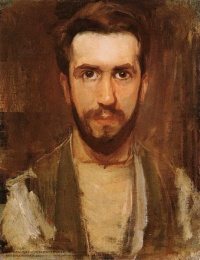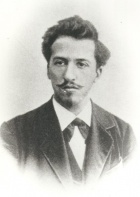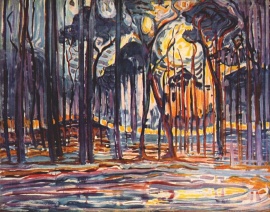Piet Mondrian
UNDER CONSTRUCTION
UNDER CONSTRUCTION
Pieter Cornelis "Piet" Mondrian (March 7, 1872 – February 1, 1944), was an influential Dutch painter, and one of the founders of the Dutch modern movement De Stijl. He also evolved a non-representational form that he termed neoplasticism, which consisted of white ground, upon which he painted a grid of vertical and horizontal black lines and the three primary colors.
Early life and education
Artistic career
Significant works
Woods Near Oele: This large canvas, whose subject has been identified... as the woods near the village of Oele... marks a milestone in the painter's work. It shows the phase of his art in which his horizon opened up and he began to look beyond the somewhat narrow boundaries of the Dutch school...
The painting itself is clearly a transitional work. On the one hand it belongs... to a period in which a scene of nature is brought to sober, almost solemn simplicity by means of rigorous stylization and stringent two-dimensional treatment. On the other hand, the color, the brushwork, and the rhythm of the painting betray a dynamism that indicates foreign influences...
The new view of reality, the realization that there are forces existing in nature related to those of human feeling and thought, stimulated Mondrian to attempt a fresh approach.[1]
Theosophical Society involvement
In 1908 Piet Mondrian became interested in the Theosophical Society. Its founder, Blavatsky believed that it was possible to attain a knowledge of nature more profound than that provided by empirical means, and much of Mondrian's work for the rest of his life was inspired by his search for that spiritual knowledge.
He radically simplified the elements of his paintings to reflect what he saw as the spiritual order underlying the visible world, creating a clear, universal aesthetic language within his canvases.
Later years
Published collections and exhibit catalogs
- Plastic Art and Pure Plastic Art, 1937, and Other Essays, 1941-1943. New York: Wittenborn and Co., 1945.
Other Resources
- Bax, Marty. "'Character Is Destiny' - Piet Mondrian and his horoscope." Bax Art Concepts & Services blog. March 7, 2013. Available at Baxpress.blogspot. Viewed October 21, 2016.
- Bax, Marty. "The Victory Boogie Woogie - a corpse dissected." Bax Art Concepts & Services blog. April 4, 2012. Baxpress.blogspot. Viewed October 21, 2016.
- Bris-Marino, "The influence of Theosophy on Mondrian’s neoplastic work" "La influencia de la teosofía sobre la obra neoplástica de Mondrian".
- The Union Index of Theosophical Periodicals lists 2 articles about Mondrian.
- Harris, Philip S. "Mondrian, Piet." Theosophical Encyclopedia (Quezon City, Philippines: Theosophical Publishing House, 2006), 542-543. Available at Theosopedia.
- Welsh, Robert P. "Mondrian and Theosophy – Part one." Theosophy Forward. September 27 2012. Viewed October 21, 2016.
- Welsh, Robert P. "Mondrian and Theosophy – Part two." Theosophy Forward December 10, 2010. Viewed October 21, 2016.
- Hall, Kathleen. "Theosophy and the Emergence of Modern Abstract Art" The Quest 90.3 (May-June 2002).


